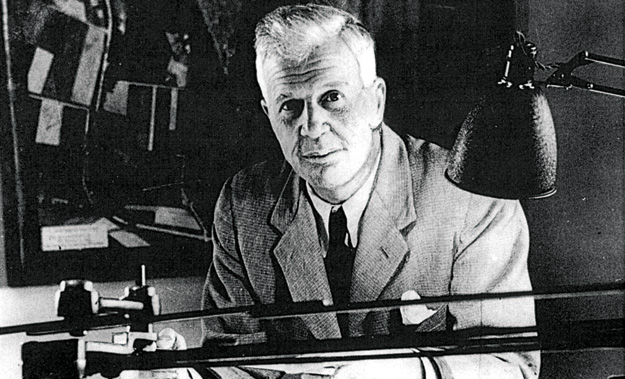Barnes Wallis, an English inventor, and physicist is best known as the person who devised and constructed the bouncing bomb that was used in the Dambusters attack in May of 1943. Wallis began his career as a marine engineer; however, he quickly realized that the aviation business was where he should focus his efforts. After working as a naval engineer for some time, he transitioned towards developing airships and eventually became involved in the creation of airplanes for Vickers. He was an essential contributor to the production of the R100, which was at the time the world’s largest airship ever created. After gaining experience in aircraft design, Wallis turned his attention to the development of bombs. He came to the conclusion that the use of bombs was the most effective method for destroying Nazi Germany’s capacity to fight a war. He conceived the idea of carrying out the Dambuster attack in such a way that there would be fewer casualties as a result. Wallis came up with the idea of a bouncing bomb in order to achieve the same goal. This bomb was used to strike the dam walls in the Ruhr valley, which caused German manufacturers and their hydroelectric power to be disrupted. Despite the fact that the bombardment did not do a significant amount of material damage, it did cause psychological harm to the German soldiers. Wallis devoted the latter part of his life to conducting studies in the field of aviation.
Childhood and the Early Years of Life
- Charles Wallis and Edith Ashby welcomed their son Barnes Wallis into the world on September 26, 1887, in the village of Ripley, Derbyshire. The couple ultimately had four children, and he was the second of those children to be born to them.
- When Wallis was just two years old, his family uprooted and relocated to New Cross Road in London, where Wallis’s father had set up a medical practice. In the year 1893, he became infected with poliomyelitis, a condition that ultimately led to his death and left him paralyzed.
- Wallis has had an interest in making things ever since she was a small child. In the family workshop, he and his younger brother created paper toys for their younger sister to play with.
- Christ’s Hospital school was where he acquired his schooling and he is a scholar of the highest caliber. Wallis opted to pursue a career in engineering after developing an interest in mathematics and science when he was attending school.
Career
- Wallis began his professional life in 1905, the year he graduated from high school, working for Thames Engineering Works, a ship engine production company. He served as an apprentice there until the year 1908.
- 1908 was the year when he started working as a marine engineer at John Samuel White’s shipyard on the Isle of Wight. Wallis, who was ambitious and looked to the future, quit his position in 1913 and found work at Vickers, a business that specialized in the creation of airships and airplanes.
- Wallis had a background in maritime engineering, thus he was completely ignorant when it came to airships and flying. In spite of the fact that he lacked information, he quickly educated himself on the subject of airships and aerial flight. In the meanwhile, he graduated from the University of London External Programme with a bachelor’s degree in engineering in 1922.
- As a result of the Admiralty’s refusal to spend money on the construction of airships during World War I, Wallis had a brief period of unemployment. After making the decision to join the military, he was summoned back by Vicker’s airship development team.
- In 1930, Wallis became actively involved in the process of developing R100. In this period of his career, he achieved a number of firsts, including the application of geodetic design in engineering and the wiring of gasbags. He was a contributor to the construction of what was, at the time, the biggest airship that had ever been created. In addition to that, he was John Edwin’s assistant in the structural design of R100.
- Wallis relocated to the Brooklands location of the Vickers aircraft manufacture. In this regard, his geodetic design was utilized in the fuselage and wing construction of all pre-war aircraft designs, including Wellesley, Wellington, and Warwick.
- Wallis was promoted to the position of associate chief designer in Vicker’s aircraft branch shortly after the outbreak of the Second World War. Soon after, he came to the conclusion that the only way to prevent the adversary from starting a war was through the use of strategic bombing. In connection with the same topic, he wrote a paper entitled “A Note on a Method of Attacking Axis Power.”
- Wallis proposed that destroying the enemy’s industrial foundation would be the quickest method to win the war against the adversary. If there were no manufacturers, there would be no supplies for the military, and there would be no war. In order to put his plan into action, he conducted a study and discovered that the Ruhr was the most significant industrial base for Nazi Germany.
- Wallis came up with the concept that attacking dams would essentially serve the objective of disrupting the industrial base, and he put this concept into action. If dams were breached, they would release a massive amount of water that had been held back, which would then cause the destruction of everything in its path.
- In order to carry out his plan to attack dams, he designed a bomb in the shape of a revolving drum. This weapon would launch itself over the water, roll down the dam’s wall, and then detonate at the dam’s foundation. This would make it less likely that the bomb would injure an aircraft while also increasing its effective range.
- Wallis received approval to proceed with the project when the Air Force was won over by the concept of the bouncing bomb. They sent an order to Wallis to make bombs in preparation for an assault on the Mohne, Eder, and Sorpe dams located in the industrial district of Ruhr in Germany. The bomb was referred to by its code name, Upkeep.
- The Royal Air Force’s newly formed 617 Squadron participated in the Dambuster mission, which was codenamed Operation Chastise and carried out on the 16th and 17th of May, 1943. The breaching of two dams, the Mohne and the Eder, inflicted significant damage to Germany’s industrial base and interfered with the country’s ability to generate hydroelectric power. Despite the fact that the physical impact of the Dambuster operation wasn’t as great as Wallis had anticipated it to be, the raid nonetheless caused the Axis Forces’ minds to be shaken.
- Wallis came up with the “Tallboy” and “Grand Slam” bombs as a direct result of the success of the “bouncing bomb.” The former weighed in at 6 tonnes, while the latter came in at a whopping 10 tonnes. They were employed against critical targets including as launch sites for V-2 rockets, pens for submarines, huge civil projects, and the German battleship Tirpitz.
- Wallis returned to Brooklands after the end of the Second World War to take over as the Head of the Vickers-Armstrongs Research and Development Department. He devoted the second half of his career to the creation of innovative aerospace projects of the future such as swing-wing technology, supersonic flying, and other similar things.
- Wallis developed a rocket-propelled torpedo known as HEYDAY in the 1950s. It was fueled by compressed air and hydrogen peroxide. He devised a glassless mirror that did not mist and was constructed of a polyester that was not combustible and could not be broken. In 1955, he served as a consultant for the construction of the Parkes Radio Telescope in Australia. This observatory is still in operation today.
- The concept of an “all-speed” airplane was the focus of significant research and development efforts during the majority of the 1960s. He suggested designing a plane that would be efficient at flying at all speeds, from subsonic to hypersonic, and everything in between.
Major Works
- The design of the bouncing bomb, which Wallis termed Upkeep and which was employed by the Royal Air Force in the Dambuster operation in May 1943, was perhaps the crowning achievement of Wallis’s long and illustrious career. During World War II, Wallis’ bouncing bomb was employed in an operation that was given the code name Operation Chastise. The target of the strike was a dam in the Ruhr region that contained the rivers Mohne, Eder, and Sorpe. He was under the impression that if they were able to break the dam wall, they would be able to damage Nazi Germany’s industrial base and therefore throw off their war plans.
- Awards & Achievements
- Wallis received the honor of Fellow of the Royal Society in the year 1945.
- In recognition of his work as an engineer and inventor, he was awarded the title of “Sir” in 1968. In addition to this, the Royal Commission on Awards to Inventors granted him the sum of ten thousand British pounds for the creation of the bouncing bomb.
Personal Life & Legacy
- At a family gathering, Wallis first made the acquaintance of Molly Bloxam, who would later become his wife. The two got along well right away. Even though Bloxam’s father prohibited her to pursue a romantic relationship with Wallis, the two stayed in correspondence with one another. The couple quickly became inseparable when they began dating. On April 23, 1925, they exchanged their vows and became husband and wife.
- Barnes, Mary, Elisabeth, and Christopher were the couple’s four wonderful children that came into the world. In addition to this, they took in Molly’s sister’s children after they were left without a parent and raised them as their own.
- In Effingham, Surrey, England, on October 30, 1979, he took his last breath and passed away. The nearby St. Lawrence Church was the location of his burial.
- Wallis has been memorialized in a significant way due to the significant contributions he made as an innovator and engineer. There are drinking establishments that bear his name. In addition to this, a structure at Nottingham Trent University has been named after him. Numerous monuments, busts, and plaques depicting him may be seen in various locations across the world.
- The Dambusters raid is chronicled in an exhibit that is on permanent display at the Yorkshire Air Museum. It consists of a catapult that was used to skim stones in order to test the bouncing bomb theory as well as a reproduction of the bouncing bomb. A concise history of Wallis’s work is presented for the purpose of educating visitors and keeping them up to date.
- Barnes Wallis’s name has been given to a number of streets, squares, and drives in the area. He has appeared in a number of different works as a made-up character. It is interesting to note that in the game of golf, a shot that is played so that it rolls over the top of a water hazard is called a Barnes Wallis.
Author Profile

- Formerly a senior accountant with a business degree, Linda now manages to generate story ideas; planning, assigning, and editing content for our website.
Latest entries
BusinessMay 15, 2024Partnership Vs. LLC: What’s The Difference?
BusinessMay 9, 202410 Powerful Marketing Ideas For Real Estate Agents
BusinessMay 3, 2024The Benefits Of Using An In-House Courier Service For Your Retail Business
BusinessApril 27, 2024Key Things To Consider Before Expanding Your Business






















